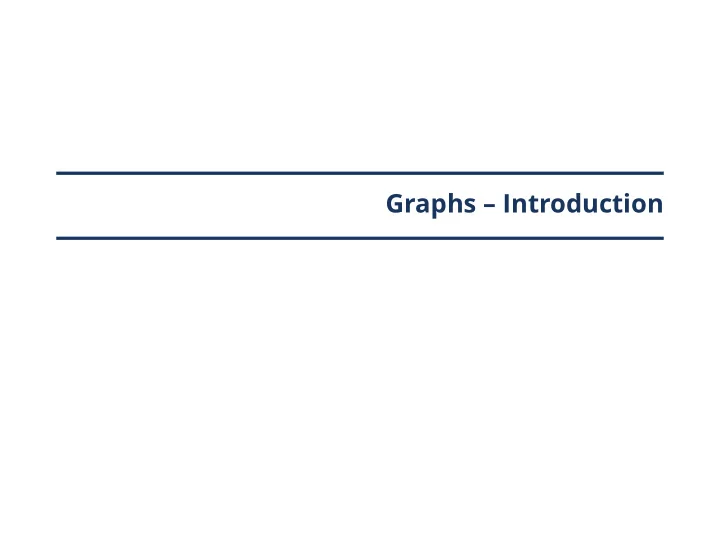

Graphs – Introduction
Graph Graph A graph G = ( V , E ) is a set V of vertices connected by an edge set E . 2 / 13
Variations Multi-Graph: Multiple edges between two vertices. Directed: Edges have a direction. Weighted: Vertices and/or edges have weights. Simple: No multiple edges, no loops. Simple Undirected Graph A simple undirected graph G = ( V , E ) is a set V of vertices connected by � � an edge set E ⊆ { u , v } | u , v ∈ V , u � = v . An edge { u , v } is usually written as uv . 3 / 13
Implementation: Adjacency List For each vertex, there is an array storing “pointers” to all neighbours. (Usually, the vertex index is su ffi cient.) 0 1 3 4 1 1 0 2 5 2 5 2 1 3 0 3 0 2 4 4 0 3 5 3 4 G 5 1 4 4 / 13
Adjacency Adjacency Two vertices u and v are adjacent if there is an edge connecting them. This is sometimes written as u ∼ v . v a c b v is adjacent to b and c but not to a . 5 / 13
Neighbourhood Neighbourhood The open neighbourhood N ( v ) = { u ∈ V | u � = v , u ∼ v } of a ver- tex v is the set of vertices adjacent to v (not including v ). The closed neighbourhood N [ v ] = N ( v ) ∪ { v } includes v . v a c b N ( v ) = { b , c } N [ v ] = { v , b , c } 6 / 13
Degree Degree The degree deg ( v ) of a vertex v is the number of incident edges. Note that the degree is not necessarily equal to the cardinality of neighbours. v a c b deg ( v ) = 3 deg ( a ) = 1 deg ( b ) = 5 deg ( c ) = 1 7 / 13
Path Path A set P = { v 0 , v 1 , . . . , v k } of distinct vertices is called path (of length k ) if v i is adjacent to v i + 1 for all i with 0 ≤ i < k . b a c d e f g h i P = { h , e , c , b , f , g , i } is a path of length 6. 8 / 13
Cycle Cycle A path P = { v 0 , v 1 , . . . , v k } is called cycle (of length k + 1 ) if v 0 is adjacent to v k . b a c d e f g i h { h , e , c , b , f , g } is a cycle of length 6. 9 / 13
Distance Distance The distance d ( u , v ) of two vertices u and v is the length of the shortest path from u to v . u v d ( u , v ) = 3 10 / 13
Subgraph Subgraph A graph G ′ = ( V ′ , E ′ ) is a subgraph of a graph G = ( V , E ) if V ′ ⊆ V and E ′ ⊆ E . G ′ G Note that u , v ∈ V ∩ V ′ and uv ∈ E does not imply uv ∈ E ′ . 11 / 13
Induced Subgraph Induced Subgraph For a graph G = ( V , E ) and a set U ⊆ V , the induced subgraph G [ U ] of G is defined as G [ U ] = ( U , E ′ ) with E ′ = { uv | u , v ∈ U ; uv ∈ E } b b a a c c d d e f e f g g h i i h � � { b , c , d , e , f , g } G G 12 / 13
Connected Component Connected Component A connected component of an (undirected) graph is a maximal subgraph in which any two vertices can be connected by a path. A graph with three connected components. 13 / 13
Recommend
More recommend